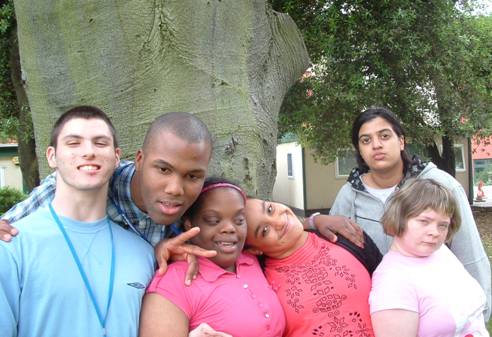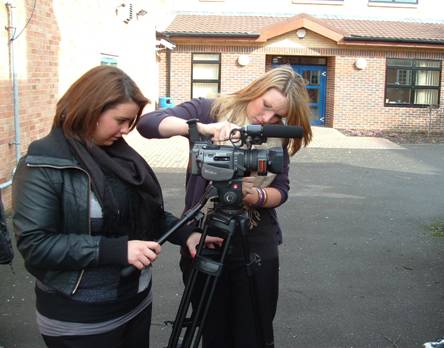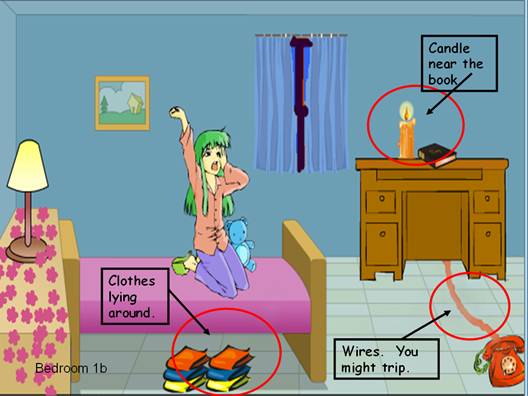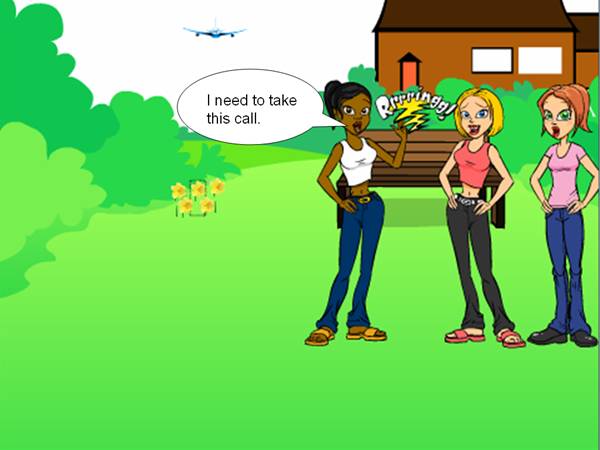Resources | Community Cohesion | Cross-curricular | Case Studies | Seminar Materials | Links Archive
Community Cohesion 2: Keeping Safe
Lorian Mead, NHS Kingston
Lloyd Mead, Lambeth College
Lawrence Williams, The Holy Cross School
Abstract
The cross-agency project described in this paper builds on the success of an earlier collaboration, called “Healthy Eating”, by the same team of participants (See JAT 3.1 March 2009). Personal safety has become an issue of national importance, and here we outline the aims and objectives, the project development, and our plans for the future. A film brief was provided by NHS Kingston Occupational Therapists (OTs), as there was a need within the organisation for training resources, for adults with learning disabilities, about keeping safe in a range of different settings. The film DVD commission provided by NHS Kingston was specific to their own personal safety resource needs, but it had sufficient flexibility to allow the Lambeth College students to develop many personal skills, and to give Holy Cross Year 12 Media students and Year 9 Technology students the opportunity to be creative.
Key words:
cross-agency links, personal safety, AS level media, ICT tools for learning,
creativity
 Participants
Participants
NHS Kingston
Lorian Mead (Head OT, NHS Kingston)
The Holy Cross School
Lawrence Williams (Head of Creative Development)
AS Level Media Students: Danielle Beaumont
Grace Moppett
Nicole Mifsud
 Lambeth College
Lambeth College
Lloyd Mead (Tutor)
Lambeth College students (City and Guilds)
Amal Ossable, Ugonna Onyebalu, Gifty Hammond, Shazia Akhtar,
Louise McMullan, Sarita Smith, Christopher Wilkinson
A. Project aims
- To continue the development of links between the National Health Service, secondary education, and Further Education
- To build on the success of the Healthy Eating Project, 2007 - 2008
Objectives
NHS Kingston
- To commission a DVD about “Keeping Safe” for Occupational Therapists to use to support their work in Kingston and Richmond
- To use the DVD for training purposes to use alongside existing resources
- To promote the involvement of people with learning disabilities as partners within service development work
Holy Cross School
- Academic: To meet the needs of students studying AS Level Media
in three units of their course:
- Work Experience
- Making a Video
- Presentation Skills
- Citizenship: To provide AS Level and Year 9 students with the opportunity to use their ICT skills in support of the project of benefit to the wider community
- To develop baseline knowledge of the principles of accessible information for people with learning disabilities
- To build stronger cross-agency links
Lambeth College
- For students to be provided with the opportunity to participate in a socially inclusive project
- For students to participate actively in the making of a positively presented film about keeping themselves safe, in a variety of social contexts
- To fulfil a unit in the City and Guilds course qualification
All the students who took part in the project from Lambeth College are on the 16 - 19 Preparation for Vocational Skills course for City and Guilds, Entry level 1. The entry requirements for this course are that all the students have to have a learning disability, with an entry 1 or 2 in Numeracy and Literacy Skills.

B. Project planning
A project planning meeting with all three partners was undertaken in September 2008. NHS Kingston stated their interest in commissioning the DVD, and outlined their need for training resources, for adults with learning disabilities, that could be used to provide positive visual images in order to reinforce skill development in keeping safe. The inclusion of people with learning disabilities in the development of the DVD was an integral component of the project. The DVD also needed to cover the areas of the existing keeping safe work. A record of the planning decisions made at this meeting can be found at the end of this report in the planning details section.
Script development
The outline for the DVD was further developed in an additional meeting between
the occupational therapy service and Lambeth College. During this meeting
a list of key components for each scene was developed to balance the needs
of the occupational therapy service with the interests and abilities of
the Lambeth College students. For example, some scenes were non verbal
and some voice-overs were incorporated.
The outline provided by NHS Kingston was specific to their own service needs, but it had sufficient flexibility to enable the Lambeth College students to be creative, and to use their own knowledge and experiences. This flexibility was incorporated to enable maximum participation in the project from students with learning disabilities who also had a range of learning and verbal abilities.
C. Project development
Lambeth College Student Experiences
Preparation
The students did their planning throughout the first half of the Autumn
Term. This initially involved a wider discussion about keeping safe based
on the
individual experiences of the students. Once the topic had been introduced
and students had familiarised themselves with areas of promoting personal
safety; the project was introduced as an opportunity to further support
their learning. At this stage, information was given to the students
that when
it came to filming they could choose whether to opt in or not. As in
the previous project accessible video consent forms were used to support
students
to make informed choices.
The students then considered the components of the project, and, through topic work, considered the props the script would need, and the potential locations, in addition to practising role playing within a range of scenarios. The students took it in turns to act out the different scenarios, and to try out different roles, in order to see who felt comfortable at acting, and who the best actor for the part might be. This was done through the students appraising each other’s performances, until it was agreed who would be taking which part. As different students did the acting, different interpretations of how to be safe arose. This, in itself, led to useful further discussion about ways to keep safe.
Preliminary filming at Lambeth College
The filming took place at the College and gave all involved a chance to get
to know each other, and to demonstrate their acting skills. The Lambeth
students acted through the different scenarios in the College in a familiar
setting, so that they felt comfortable. A few weeks later, the students
were able to watch the film, and this was a chance to review and reinforce
their work around keeping safe.
Preliminary filming at Holy Cross
The students then went to the Holy Cross School to see the community setting
where the final filming would take place. This visit aimed to familiarise
Lambeth College students with the locations for the final filming, in addition
to meeting the Holy Cross students again. Students from Lambeth College
were also given a tour of the Holy Cross site and shown where the editing
of the DVD would take place.
Final filming
On day one of final filming, Lambeth College students were arrived at Holy
Cross and asked whether they were feeling confident, and a final check
was made as to whether they wanted to go ahead with the filming.
Holy Cross students gave a demonstration of the professional equipment that had been hired for the final filming. Lambeth College students gave an overview of the scenes that had been rehearsed and “walked through” some scenes, so that the positioning of the cameras could be finalised. Scenes were then filmed and often small differences would occur during the 1-2 min clips, which resulted in the need for each clip to be filmed at least three times.
On day two of the final filming the Holy Cross students paid a return visit to the College to film the “shop scene”. We had two actors to buy food from a shop. This took at least five takes, due to other things happening in the shop! Also, on this day, the sound recording for the previous day’s filming was added.
After the filming
The Year 9 Technology/ICT students at Holy Cross created PowerPoint slides
of similar scenarios to the “Keeping Safe” film. This is detailed
below. These files were then used at the College to reinforce the learning
steps around keeping themselves, their property and possessions, safe.
Although not all the students are in the filmed scenes, the whole group took an active part in the perusal of the scripts, and made amendments, or provided props and scenery. The making of the film has kept an important topic fresh in the students’ minds, with continual reminders.
Conclusion (Lambeth College)
Through taking part in the project, Lambeth College students were given the
opportunity to participate in a multi-agency project in which they were
key partners. All those doing acting roles stated that they really enjoyed
taking part in the filming, and working with the group of students from
Holy Cross. Within the classroom, most of the students were interested
in the topic of keeping safe most of the time. These lessons involved a
better level of engagement than other lessons the students participated
in. This could be due to the students being able to have visual feedback
of their own performance and other students were able to contribute their
feedback as well. This led to broad discussions about students’ personal
experiences and students were given positive feedback from their peers
when they were making safe choices. It was also noted, and of interest
to the tutor, that this academic year fewer students lost personal items,
including college passes, than in the seven previous years of teaching
experience at the college.
Project Development – The Holy Cross Perspective
At Holy Cross, the project began in September, 2008 when the aims and objectives were decided. Following a preliminary visit by the Lambeth College students to Holy Cross School, and some trial filming, it became apparent that the school cameras would be unsuitable to produce the high quality needed to create a professional, finished result. In response to this problem, the NHS kindly offered the school a budget of £300 to hire a suitable professional quality camera, and sound boom.

In March 2009, Holy Cross AS level Media students took possession of a Sony PD150 camera, on hire for several days to allow familiarity with the equipment, and a further two days of filming. Lambeth College students, who had practised their roles in the filming, arrived at the school on March 4th to work on the final shoot. They filmed seven scenes in all. Then, the following day, the AS Media students travelled to Lambeth College in order to add the voice-over necessary to make sense of the outdoor filmed scenes.
Meanwhile, Year 9 Technology/ICT students at Holy Cross were busy adding two further dimensions to the project:
Flash Cards – a creative dimension to the project using ICT
tools
Using a creative mix of images from the “ToonDoo” cartoon web
site, and text files added into a PowerPoint, Year 9 girls made a series
of “Keeping Safe” flash cards to support the project. Following
a strict Technology design brief, they made a series of coloured cards sets,
each set showing:
a. a scene where three things in the picture could be seen to be unsafe
b. a second “card” in which the problem was circled in red (example below)

c. a third card with the safety issue resolved
These pages were then printed out in colour, and laminated for durability. Moreover, because they were in digital format, aspects were then animated in a variety of ways, and the files were also saved onto disc. This meant that they could now be used on an interactive white board for further training purposes, using kinaesthetic learning techniques. This work may provide us with a lead into the next project, specifically on kinaesthetic learning.
Alternative visual dimension added, with animated images

In order to act as a lively introduction to the more serious filmed scenes on the final Keeping Safe DVD, and to deploy a second visual learning skill, cartoon versions of the actual filmed scenarios were created, in a similar way to the Flash Cards, described above. The text used by the Lambeth College students in their acting was added into the PowerPoint pages as “thought bubbles” and/or speech bubbles, to show the thinking processes needed in keeping safe in different situations.
On reflection, however, it was decided that this cartoon element, while lively and creative, should be kept separate from the main DVD, rather than being incorporated into the filmed version.
In this way, the project as a whole explored new ways of using visual learning techniques:
- Cartoons, including student animations
- Flash cards
- Digital film (stills, and movie)
The Holy Cross AS Media students then spent time editing the scenes, and produced a final DVD to pass on to the NHS, for actual use in their local training. All three parties benefited enormously from their involvement in the project. Grace comments, “This was a wonderful project for our group to be involved in. Not only were we able to meet three of our AS Level Media course requirements, but we were also able to work with people from Lambeth College, as well as creating a resource that will actually be used to support safety issues in our local community.”
Occupational Therapy Perspective
The occupational therapy service was involved in the initial stage of the project planning, in the development of the script and in viewing the draft DVD. Throughout the project the occupational therapy service had a consultancy role, and identified opportunities to experience and participate in new occupational roles e.g. as actors, directors, narrators. These included:
- Positive images of self
- Confidence and self esteem
- Learning through doing
- Work role development
- Health and safety promotion
- Wider picture other local agencies such as the police
Planning details
The DVD
- A DVD to be used for training purposes
- Number of clips, 5 to 10, depending on time and other constraints (7 were actually completed)
- Length of video clips, 1 to 2 minutes each, depending on context
- Places for filming: Kingston local area (external) and Lambeth College (internal)
- Editing: by Holy Cross students using Apple Mac editing software
- Format: iMovie
- Playable on TV screen and laptop computer
And on the disc, in separate sections:
- A Word document detailing the process – academic use
- A Word document detailing the therapeutic aspects of the project
- Cartoon versions of the scenes, made using ToonDoo and Draw files, imported into PowerPoint
- Laminated Flash Cards
Film structure
- Background music during the opening credits
- Freeze-frame introductory page for each scene, with background music (To allow users to scroll though to the relevant video clip)
- Sound effects during the individual filmed scenes to be appropriate to the context
- Background music during final credits
- Credits to have all students’ names
Costs of hiring a high quality camera:
- £ 60 per day or
- £ 240 per full week
- Likely hire cost: £300 (for one week, plus one occasional follow-up day)
Scenes to be filmed
- Looking after your bag safely
- Telling parents where you are going and what time you will be back
- Locking the front door securely after arriving home
- General road safety (various)
- Looking after your mobile phone
- Answering your mobile
- Safe places to walk
- Dealing with strangers
- Getting ready to go out
- Items in bag; keys purse; mobile; freedom pass
- Securing items in bag (closing it securely)
- Letting someone know that you are going out
Conclusion
This has, once again, been a highly successful cross-agency collaboration in which our experience of working together has been both reinforced and enhanced. All three parties have completed what they set out to achieve:
- The NHS now has a useful DVD with “Keeping Safe” film clips which can be used for OT training purposes
- Holy Cross students, in Years 9 and 12, had the opportunity to be creative within a project which developed their ICT and Media skills, as well as enhancing their knowledge about the needs of people in the local community
- Lambeth College students have gained confidence in their acting skills, as well as learning how to keep safe
The next area for us to explore is kinaesthetic learning, and the ways in which the differing skills of the current team can be deployed to develop collaborative materials in this area.
[Back]

